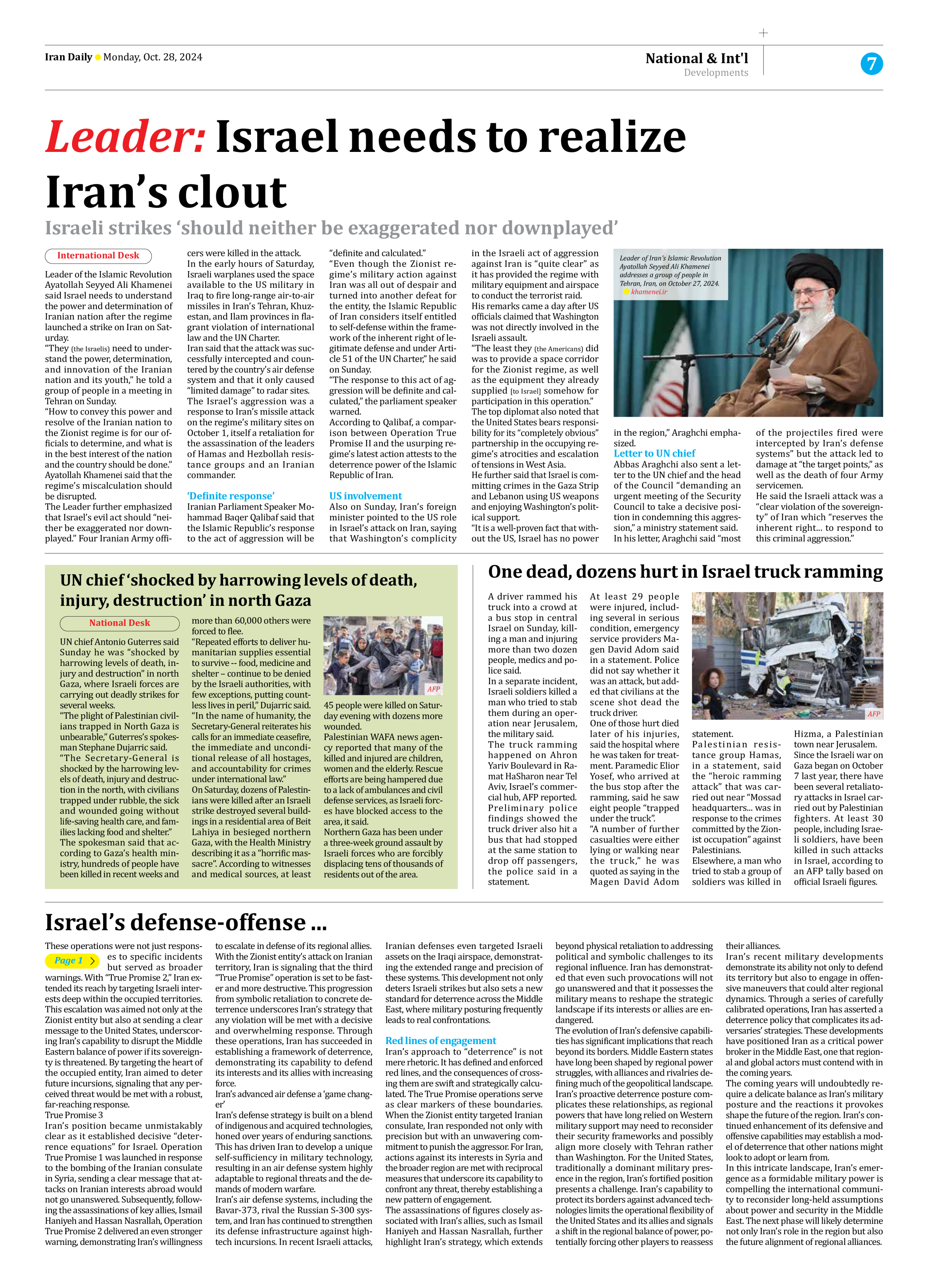
Israel’s defense-offense ...
Page 1
These operations were not just responses to specific incidents but served as broader warnings. With “True Promise 2,” Iran extended its reach by targeting Israeli interests deep within the occupied territories. This escalation was aimed not only at the Zionist entity but also at sending a clear message to the United States, underscoring Iran’s capability to disrupt the Middle Eastern balance of power if its sovereignty is threatened. By targeting the heart of the occupied entity, Iran aimed to deter future incursions, signaling that any perceived threat would be met with a robust, far-reaching response.
True Promise 3
Iran’s position became unmistakably clear as it established decisive “deterrence equations” for Israel. Operation True Promise 1 was launched in response to the bombing of the Iranian consulate in Syria, sending a clear message that attacks on Iranian interests abroad would not go unanswered. Subsequently, following the assassinations of key allies, Ismail Haniyeh and Hassan Nasrallah, Operation True Promise 2 delivered an even stronger warning, demonstrating Iran’s willingness to escalate in defense of its regional allies.
With the Zionist entity’s attack on Iranian territory, Iran is signaling that the third “True Promise” operation is set to be faster and more destructive. This progression from symbolic retaliation to concrete deterrence underscores Iran’s strategy that any violation will be met with a decisive and overwhelming response. Through these operations, Iran has succeeded in establishing a framework of deterrence, demonstrating its capability to defend its interests and its allies with increasing force.
Iran’s advanced air defense a ‘game changer’
Iran’s defense strategy is built on a blend of indigenous and acquired technologies, honed over years of enduring sanctions. This has driven Iran to develop a unique self-sufficiency in military technology, resulting in an air defense system highly adaptable to regional threats and the demands of modern warfare.
Iran’s air defense systems, including the Bavar-373, rival the Russian S-300 system, and Iran has continued to strengthen its defense infrastructure against high-tech incursions. In recent Israeli attacks, Iranian defenses even targeted Israeli assets on the Iraqi airspace, demonstrating the extended range and precision of these systems. This development not only deters Israeli strikes but also sets a new standard for deterrence across the Middle East, where military posturing frequently leads to real confrontations.
Red lines of engagement
Iran’s approach to “deterrence” is not mere rhetoric. It has defined and enforced red lines, and the consequences of crossing them are swift and strategically calculated. The True Promise operations serve as clear markers of these boundaries. When the Zionist entity targeted Iranian consulate, Iran responded not only with precision but with an unwavering commitment to punish the aggressor. For Iran, actions against its interests in Syria and the broader region are met with reciprocal measures that underscore its capability to confront any threat, thereby establishing a new pattern of engagement.
The assassinations of figures closely associated with Iran’s allies, such as Ismail Haniyeh and Hassan Nasrallah, further highlight Iran’s strategy, which extends beyond physical retaliation to addressing political and symbolic challenges to its regional influence. Iran has demonstrated that even such provocations will not go unanswered and that it possesses the military means to reshape the strategic landscape if its interests or allies are endangered.
The evolution of Iran’s defensive capabilities has significant implications that reach beyond its borders. Middle Eastern states have long been shaped by regional power struggles, with alliances and rivalries defining much of the geopolitical landscape. Iran’s proactive deterrence posture complicates these relationships, as regional powers that have long relied on Western military support may need to reconsider their security frameworks and possibly align more closely with Tehran rather than Washington. For the United States, traditionally a dominant military presence in the region, Iran’s fortified position presents a challenge. Iran’s capability to protect its borders against advanced technologies limits the operational flexibility of the United States and its allies and signals a shift in the regional balance of power, potentially forcing other players to reassess their alliances.
Iran’s recent military developments demonstrate its ability not only to defend its territory but also to engage in offensive maneuvers that could alter regional dynamics. Through a series of carefully calibrated operations, Iran has asserted a deterrence policy that complicates its adversaries’ strategies. These developments have positioned Iran as a critical power broker in the Middle East, one that regional and global actors must contend with in the coming years.
The coming years will undoubtedly require a delicate balance as Iran’s military posture and the reactions it provokes shape the future of the region. Iran’s continued enhancement of its defensive and offensive capabilities may establish a model of deterrence that other nations might look to adopt or learn from.
In this intricate landscape, Iran’s emergence as a formidable military power is compelling the international community to reconsider long-held assumptions about power and security in the Middle East. The next phase will likely determine not only Iran’s role in the region but also the future alignment of regional alliances.







